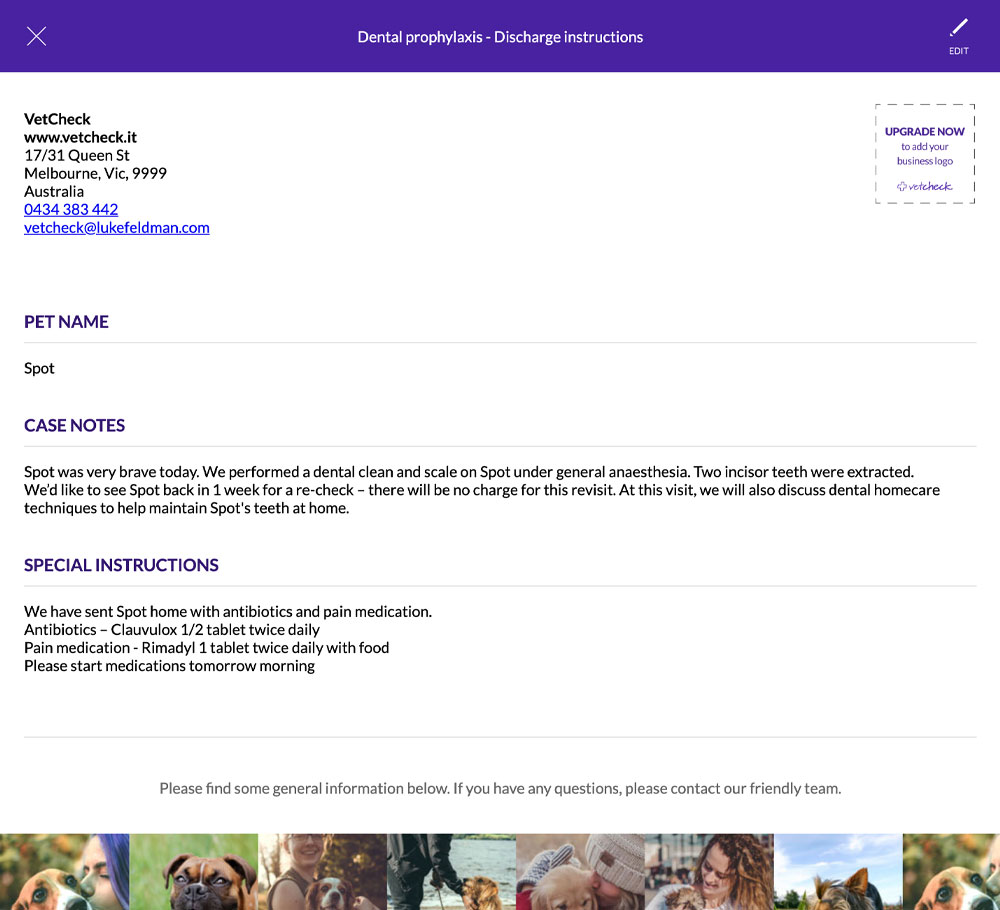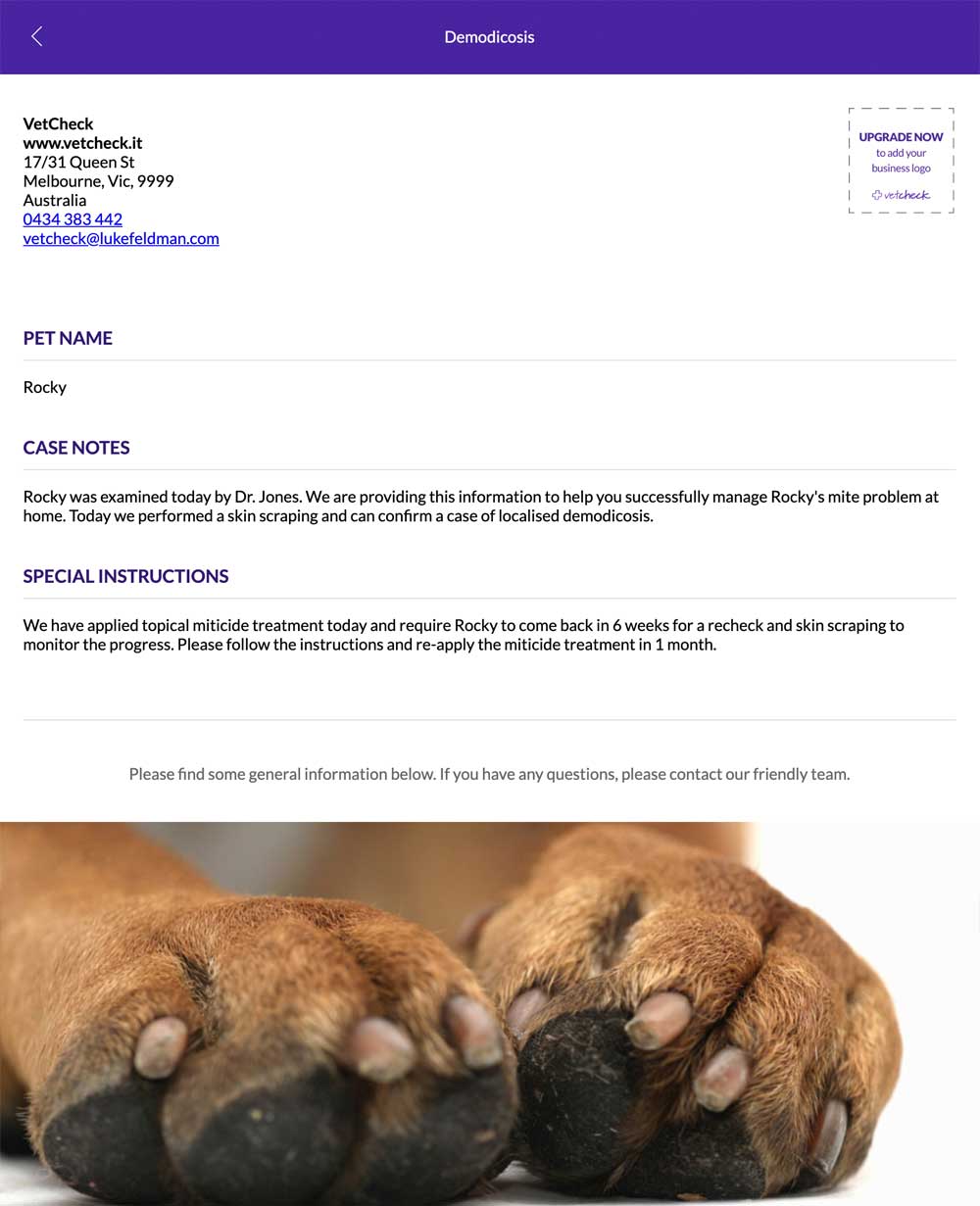
How to perfect the discharge instructions.
A lot of professional time, knowledge and skill goes into helping each patient. However, when it comes to achieving the best health outcomes, we must invest time into the client.
Your discharge instructions, treatment plans and care plans are one of the most important parts of your clinical process. It can make or break the outcomes of your clinical treatment, build stronger client relationships and make a strong professional impression.
It represents you as a clinician and demonstrates all the hard work and care that has gone into treating the client's pet and illustrates your skills. Designing your own specific case discharge instructions and plans is easy with VetCheck templates.
Digital discharge instructions not only add value and demonstrate a high quality of care, they are an important document in delivering your clinical expertise and recommendations in a way that your clients will best understand. Around 99% of customers engage with every VetCheck pet report shared from the system.
If you think about your own experience at your healthcare providers, how much do you actually take in? Pet owners don't necessarily have a background in healthcare and are often distracted by their pet at the vet visit. So, it is important to help set the client up with all the information they need before they leave to increase client satisfaction, compliance and most importantly to get the best pet health outcomes.
Why share discharge instructions
- People remember 20% of what they hear, 40% of what they read and 70% of what they see and read (Rouwenhorst 1996)
- Pet owners only take in 40% of what is said verbally
- 80% of customers do not follow recommendations due to confusion and only 20% due to costs (Todd 2008)
- Empathy and clear written instructions results in customer satisfaction and adherence. (Meehan 2011)
How to write discharge instructions
- Avoid veterinary jargon
- Keep your message to a few sentences
- Write at a level of a 5th grader
- Always forward book and confirm the next appointment in writing
What to include in your discharge instructions
- Offer a written summary with a clear diagnosis at the top in everyday language
- Summarise what diagnostics were done and what happened
- List medications – what it is (antibiotic, pain relief, antacid etc), when to give and when to start
- Provide follow up information e.g. rechecks, what to expect, when to be concerned, further bloodwork or x-rays and list pending tests
- Use handouts e.g. how to make a bland diet after gastro
- Use visuals and videos to help with home care compliance e.g. how to apply eye medication
- Next appointment
Digital discharge instructions that are optimised for mobile and more readily engaged with and allow the client to quickly contact the practice from the report in the case of an emergency.
Increase the uptake of your recommendations by 40% with supporting discharge instructions and treatment plans.
With a 99% engagement rate with all VetCheck digital discharge instructions, you can help better inform your clients and increase satisfaction.
Common VetCheck Discharge Instruction Templates
- Surgery care
- General anaesthesia care
- Dental prophylaxis with no extractions
- Dental prophylaxis with extractions
- Lumpectomy after care
- Cruciate ligament repair
- Fracture repair
- Gastroenteritis discharge instructions
- FLUTD after care
- Urethral blockage discharge instructions
- Bandage care
- Elizabethan collar instructions
- Post heartworm treatment care
- Caring for a recumbent pet
- and more....
Sample 1 - Dental prophylaxis discharge instructions
Sample 2 - The coughing dog
You brought Sammy to be evaluated by the Internal Medicine Service today because you were concerned about his cough. Today, we performed tests that have helped us narrow down the possible causes of Sammy’s cough. Some of the results of these tests are still pending, and we do not want to initiate specific therapy until we have these results. However, in the meantime, we are starting to treat Sammy’s cough with a cough suppressant. Give the medication as described above and watch for signs of sedation. Please call us if you feel this medication does not improve his cough or if he appears overly sedate. We will call you with the results of the pending tests once they are in hand. We have booked Sammy in for a series of chest radiographs next Tuesday. He will need to be sedated for this procedure. Details of this procedure are below. Please ensure he has fasted from 10 pm on Monday night.
Sample 3 - Desexing discharge instructions
Fluffy was very brave today. She has recovered well from her ovariohysterectomy and general anaesthesia and her pain is well controlled. Please find some important information about her recovery below. Please follow the medications as per label. She will require an appointment in 10-14 days to assess her recovery. If you have any concerns, please contact us.
References
https://www.vetmed.wisc.edu/wp-content/uploads/2013/01/discharge_writing.pdf?y=15


